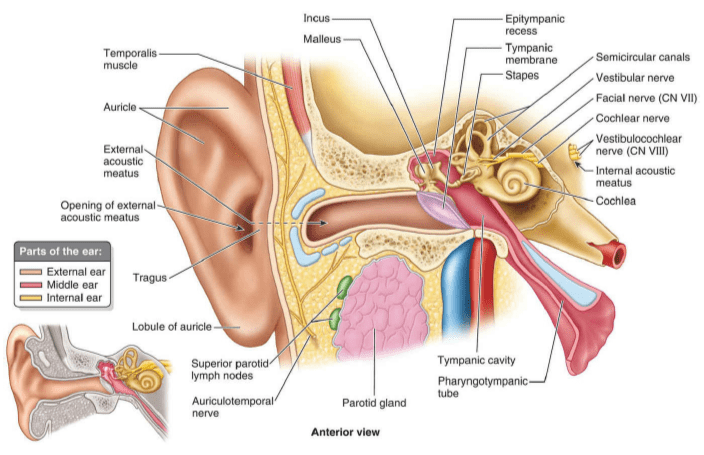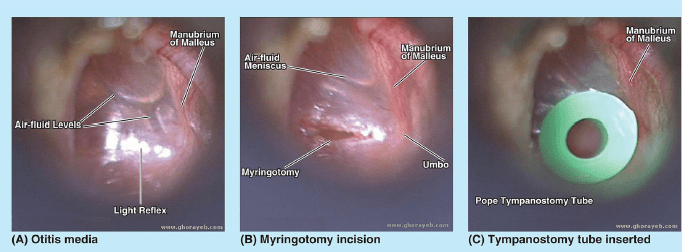Otitis Media
content of this page
1- Introduction
2- Anatomical Overview
3- Causes
4- Treatment
Introduction
An earache and a bulging red tympanic membrane may indicate there is pus orfluid in the middle ear, which is a sign of otitis media . Infection of the middle ear is often secondary to upper respiratory infections. Inflammation and swelling of the mucous membrane lining the tympanic cavity may cause partial or complete blockage of the pharyngotympanic tube. The tympanic membrane becomes red and bulges, and the person may complain of “ear popping” or crackling. An amber-colored bloody fluid may be observed through the tympanic membrane. If untreated, otitis media may produce impaired hearing owing to scarring of the auditory ossicles, limiting their ability to move in response to sound.

Anatomical Overview
Otitis media is an infection or inflammation of the middle ear, a common condition especially in children. The middle ear is located behind the eardrum and contains tiny bones that transmit sound vibrations from the eardrum to the inner ear. This area is connected to the back of the throat by the Eustachian tube, which helps equalize pressure. Otitis media often occurs when the Eustachian tube becomes blocked, usually due to a cold, allergies, or respiratory infections, leading to fluid buildup and bacterial or viral growth. Symptoms include ear pain, a feeling of fullness in the ear, and sometimes hearing loss. If untreated, it can lead to complications such as a ruptured eardrum or spread of infection.

Causes
Upper Respiratory Infections: Colds, flu, and sinus infections can lead to otitis media. The bacteria or viruses responsible for these conditions can travel to the middle ear, causing inflammation and infection.
Eustachian Tube Dysfunction: The Eustachian tube, which connects the middle ear to the back of the throat, helps regulate air pressure and drain fluids. If it becomes swollen or blocked (due to allergies, colds, or sinus infections), fluid can accumulate in the middle ear, creating an environment for bacteria or viruses to grow.
Allergies: Allergic reactions can cause inflammation and blockage of the Eustachian tube, contributing to the development of otitis media.
Adenoid Problems: Enlarged or infected adenoids can block the Eustachian tube, leading to fluid buildup in the middle ear and increasing the risk of infection.
Environmental Factors: Exposure to smoke, pollution, or allergens can increase the risk of Eustachian tube dysfunction and subsequent middle ear infections.
Age and Anatomy: Young children are more susceptible to otitis media because their Eustachian tubes are shorter, more horizontal, and more easily blocked than those of adults. Additionally, children’s immune systems are still developing, making them more prone to infections.9
Treatment
Observation: In many cases, especially for mild infections, doctors may recommend a “wait and see” approach for 48 to 72 hours to see if symptoms improve on their own, particularly in children over 6 months of age with mild symptoms.
Antibiotics: If the infection is bacterial and symptoms are severe or do not improve with observation, antibiotics may be prescribed. Amoxicillin is commonly used, but the choice of antibiotic can vary based on individual patient factors and local resistance patterns.
Pain Management: Over-the-counter pain relievers such as acetaminophen (Tylenol) or ibuprofen (Advil, Motrin) can help manage pain and reduce fever. Warm compresses applied to the affected ear can also provide relief.
Decongestants and Antihistamines: These may be used to relieve nasal congestion and improve Eustachian tube function, although their effectiveness for otitis media is variable and not universally recommended.
Ear Drops: Analgesic ear drops can be used to relieve pain in some cases. Antibiotic ear drops might be prescribed if the eardrum is perforated.
Tympanostomy Tubes: For recurrent otitis media or persistent fluid in the middle ear (otitis media with effusion), a minor surgical procedure to insert tympanostomy tubes may be recommended. These tubes help ventilate the middle ear and prevent fluid buildup.
Adenoidectomy: If enlarged adenoids are contributing to recurrent infections, surgical removal of the adenoids may be considered.
Lifestyle and Home Remedies: Ensuring good hygiene, avoiding smoke exposure, and breastfeeding infants can reduce the risk of ear infections. Keeping vaccinations up to date, including the flu vaccine and pneumococcal vaccine, can also help prevent otitis media.